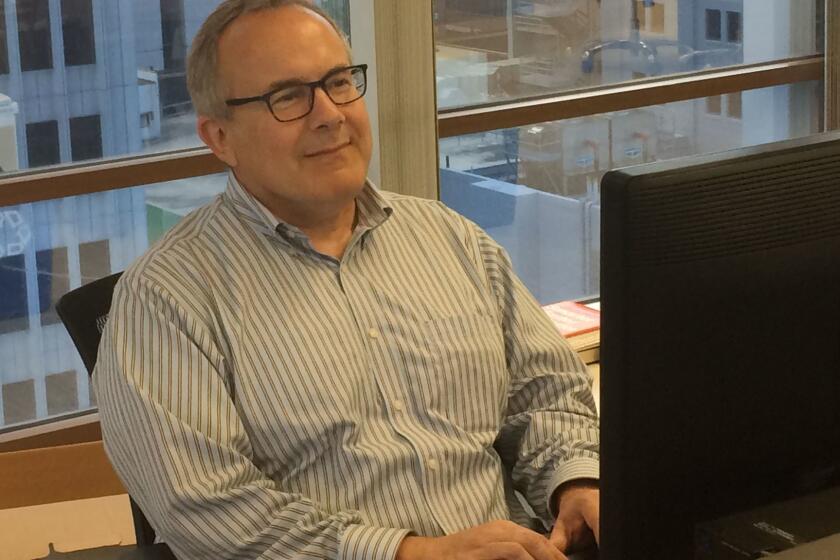California’s royals of retirement denial
For most Americans, it’s tempting to live in denial or outright fantasyland when it comes to paying for retirement.
That’s because doing the math evokes less-pleasant emotions like fear, anger or hopelessness.
Social Security, which replaces just 40 percent of the average earner’s paycheck upon retirement, is running out of money. The median household savings rate is zero. And half of workers have no pension or 401(k) account.
Commentary
More columns about Business by Dan McSwain
There’s just no way around the math. As a group, Americans have three choices: Spend less, work longer, or accept being poorer in retirement.
Not fun. Yet this dire tableau is worse than it looks, because most public pensions are in the same shape as the average worker — under-saved and overcommitted.
The difference is that pensions are guaranteed by taxpayers under California’s constitution (and those of 11 other states).
Thus a poverty spiral looms: As workers fail to stash enough cash for their own retirements, they face growing claims on income from local governments.
To see how this works, consider the plight of a San Diego household.
Officially, the pension system for city workers and retirees was underfunded by $1.54 billion as of June 30, while the county’s unfunded liability was $2.32 billion.
When you carve out city residents’ share of the county total, this combined shortfall equates to $5,400 per household.
Paycheck deductions from public workers will help, but the bulk of this responsibility falls on taxpayers.
Besides, when you add in the state figures, the real taxpayer liability is arguably closer to $62,000 per household. That’s because the official figures represent the political version of fantasyland.
Pension accounting is more art than science. Actuaries calculate today’s savings rate based on forecasts about life spans, investment returns and other factors.
No official wants to free up cash for other spending by hoping more workers will die. So the monkey business usually focuses on investment forecasts.
San Diego officials say they can reliably earn 7.25 percent a year, while their county colleagues reckon a whopping 7.75 percent.
This is astonishing, because the risk-free, 10-year Treasury paid about 2.25 percent last week.
So, by definition, our local pension officials are counting on taking considerable investment risk to earn higher returns. Of course, this increases the risk of losses to taxpayers, let alone the odds of failing to hit those rosy targets.
For perspective, federal law forces the private sector to use an index of safe, investment-grade bonds to value pension liabilities. This is precisely because executives abused return assumptions so they could save less for workers, bankrupting plans.
And the miracle of compounding does amazing things, especially in reverse. Lowering the city and county return assumptions to the bond index, which yields 4 percent these days, nearly quadruples unfunded liabilities.
If the official fantasy number is $3.86 billion, the market reality figure is $14.5 billion, using the methodology of Moody’s Investors Service, which rates municipal bonds.
This puts our typical San Diego household on the hook for $20,000 for its share of just the local pension shortfall.
Now let’s layer on the California controller’s official figure of $140 billion in unfunded obligations to teachers, state workers and university employees. The real number is probably closer to $525 billion, or $42,000 per household.
If you want to get really depressed, we can throw in $1 million per taxpayer for unfunded federal liabilities for retirement and health care payments.
Fiscal holes this big took decades to dig. The ratio of public workers to retirees was 7 to 1 in 1950, but in 2013 it was just 1.75 to 1, according the State Budget Crisis Task Force (of which California is a member).
Yet this structural contribution imbalance was an entirely predictable consequence, not an excuse.
New pension systems are often underfunded, because workers and employers have plenty of time to make contributions before retirements ramp up. By the time such systems mature, they are supposed to be fully or over-funded.
But California officials made this impossible. Starting in 1999, they boosted benefits by 50 percent. This gave retirees with 30 years of service at least 90 percent of their salaries for life, up from the standard 60 percent.
Yet instead of increasing contributions, officials cut them, partly because state actuaries predicted the booming stock and bond markets of the 1990s would continue indefinitely. They were wrong, but unduly rosy forecasts are still in vogue.
To their credit, San Diego County supervisors rolled back benefits for new hires. San Diego voters did it at the ballot box.
But cuts haven’t cured “generational inequities” that pension trustees are warned about at ethics seminars. In the moral universe of retirement plans, a worker’s retirement should never exceed — or lag — the level supported by contributions made during his or her career.
The concept makes California’s system as immoral as it is imprudent. We have people working side by side earning vastly different lifetime retirement benefits.
And giant unfunded liabilities place tomorrow’s taxpayers at risk for today’s retirees. Baby boomers could be staging history’s greatest intergenerational heist.
Meanwhile, political leaders show little appetite for remedial action. It’s a tragedy, because now is the perfect time to begin.
The U.S. economy is finally growing strongly. Employers are hiring, unemployment payments are tumbling, and cash is pouring into local, state and federal treasuries.
Such conditions create political room to increase contributions, reduce risk in portfolios, and reduce annual return assumptions to a rational 4 percent.
Yet most pensions are sticking to 7 percent-plus forecasts. And U.S. systems are taking more investment risk as they mature, unlike corporate plans or public ones in the U.K., Canada and the Netherlands, as the Society of Actuaries said recently.
If you’re like most Americans, your retirement fund is in crisis now. Just wait until the next economic downturn.
Get U-T Business in your inbox on Mondays
Get ready for your week with the week’s top business stories from San Diego and California, in your inbox Monday mornings.
You may occasionally receive promotional content from the San Diego Union-Tribune.





